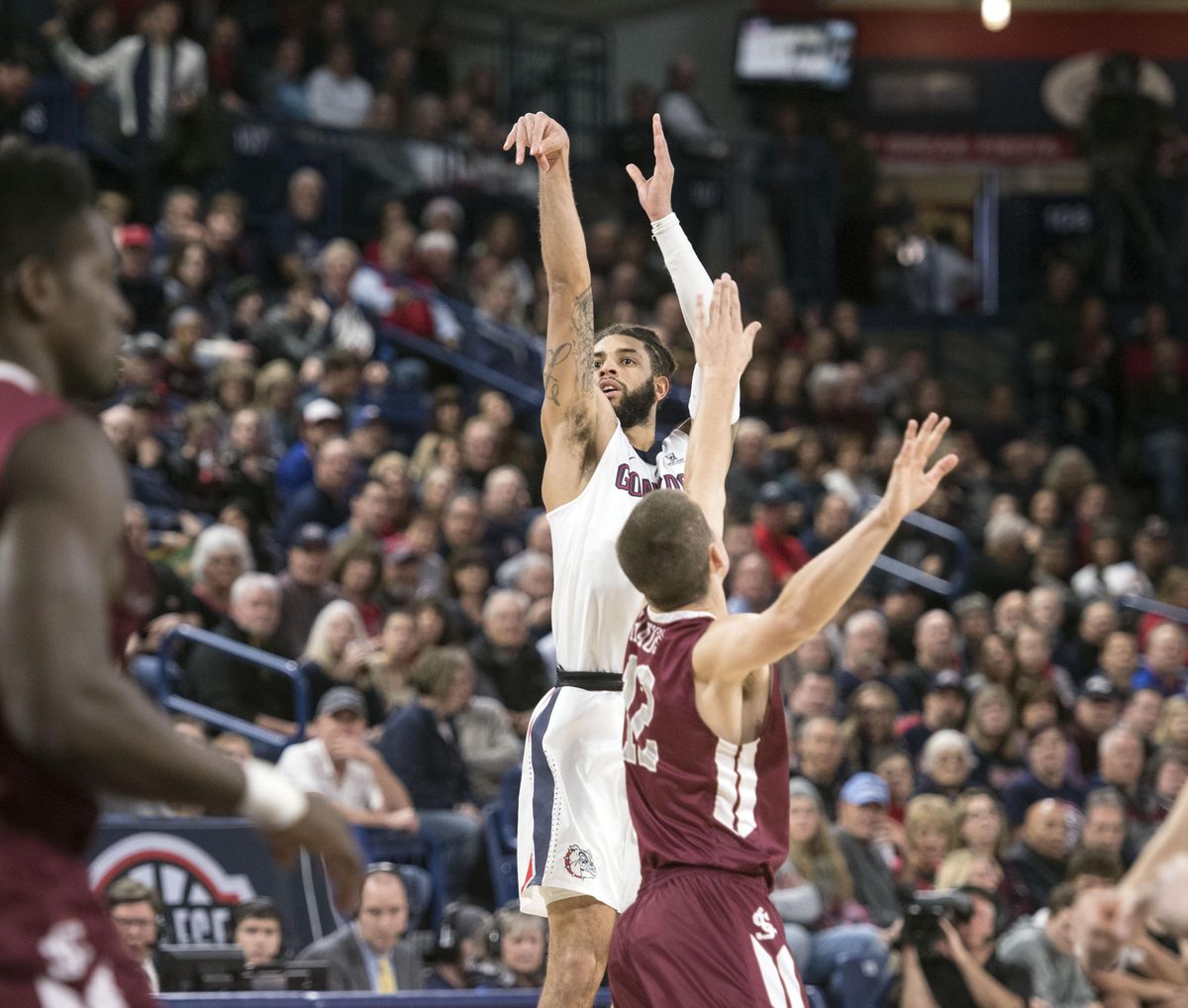John Blanchette: Gonzaga’s latest rout shows why conference schedule needs tinkering
Gonzaga guard Josh Perkins hits a 3-point shot against Santa Clara, Saturday, Dec. 30, 2017, in the McCarthey Athletic Center. (Dan Pelle / The Spokesman-Review)Buy a print of this photo
Less is more.
A comfy old shoe of a philosophy – and it slipped on easily Saturday evening. Took no longer than it did for the Gonzaga Bulldogs to get a 15-0 head start on Santa Clara.
And by the time the clock went to zeroes with the scoreboard reading 101-52 and Santa Clara coach Herb Sendek delivered the pithy postgame analysis of “We got annihilated,” it seemed like the fit of a lifetime.
Can you dig it? Less is more.
Or technically, fewer is more.
Fewer West Coast Conference games – like the one Saturday night – that don’t do the Zags any good. Or the Broncos, for that matter.
So here’s the motion on the floor: trim the number of WCC games each school plays from 18 to 16, and let them schedule two more outside the conference that better fit their needs.
For Gonzaga and Saint Mary’s and BYU, say, those would be portfolio-enhancing games for NCAA Tournament committee consideration. For a Santa Clara and any schools with a program under construction, those would be games they can win – and begin enhancing their profile so that, someday, they can be the ones seeking out resume games.
“We’re 10 individual schools and we each have to do what’s best for our school,” said Gonzaga athletic director Mike Roth. “But there are times when you have to think of what’s best for us as a group.”
Yes, this would mean the end of the true round-robin – and that the Zags would play two teams only once in the regular season.
Blasphemy?
Of course.
No conference of 10 or fewer teams plays anything but a full round-robin. Eighteen conference games is a nice, snug fit in a 30-game schedule – so nice that even the leagues of 11 members and more play 18 instead of 20 or 22.
And because everybody does it this way, it’s limited the traction this radical notion has received within the WCC. Not that it’s Gonzaga against the world, but the seeming enormity of the questions and variables have kept it from getting as far as a specific proposal, never mind a vote. And, yes, there will always been the devil in the details.
But Roth sees some urgency thanks to a different radical new idea: The Big Ten is going to a 20-game conference schedule.
Yes, someone is thinking more is more. And in no surprise, it’s a Power 5 conference looking for more slices of pie.
“They haven’t said it, but it’s being done with the hopes of getting more teams into the tournament and higher seeds,” Roth said, “because when they play within their league, their RPIs go up.”
Often as not, Gonzaga’s standing in the Ratings Percentage Index – the NCAA’s favorite comparative tool – takes a hit from a conference victory, even when the Zags look as dazzling as they did Saturday night.
Santa Clara’s RPI is 347 – fifth worst in all of Division I. Pepperdine is 324, and three other WCC teams are in the 200s. And it’s not just this year: over the past 10 seasons, six WCC teams have RPI averages of 190 or lower.
Here’s why it matters: never has the NCAA bracket been such a gated community, and almost no one’s getting in outside the Power 5 and its basketball relative, the Big East. Only four teams from other leagues got at-large berths last year, Saint Mary’s being one of them.
Here’s another reason: the WCC and its members live off the money Gonzaga – with Saint Mary’s chipping in now and again – makes in the tournament. GU’s run to the title game earned it five NCAA “shares” – each worth $1.6 million or so over the next six years. That makes 12 shares Gonzaga has earned over the last three tourneys alone, and few leagues are as dependent on NCAA Tournament money as the WCC.
That’s the Santa Claras as well as Gonzaga.
Naturally, some schools will be reluctant to give up a home game against Gonzaga – the one that packs the house and actually gets students jazzed.
“But I’ve also had a coach in our league tell me, ‘I’m trying to build my program and I don’t need to play Gonzaga twice right now to do that,’” Roth said.
OK, there’s a feel of gerrymandering here that likely doesn’t sit well in the old school ethos – and tends to mask the collective good. But lots of leagues play unbalanced schedules. Why should it be limited to those with more than 10 members?
“In our perfect world, everybody in the league helps everybody else,” Roth said. “Now, wouldn’t it help everybody to play Gonzaga? Isn’t it going to help Santa Clara in a few weeks when we come to their place? I can’t say that’s not true, necessarily. But in this case, we’re looking at a bigger picture.”
With the caption, “Less is more.”





















